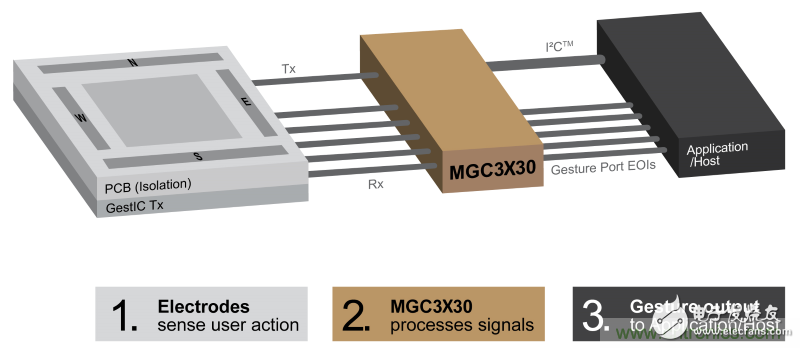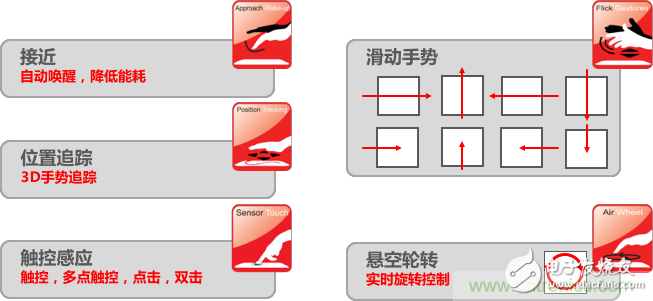Optical 3D gesture recognition still has a certain technical threshold. It is not an easy task to play around. Some technologies require further practical verification and polishing. Therefore, other non-optical 3D gesture recognition technologies have become an important option for people. One of the more representative ones is Microchip's GesTIC technology. Today we will take a look at how to play 3D gesture recognition technology based on the principle of electric field induction?
Human-computer interaction can be regarded as the most direct technology for the user experience of electronic products. When Apple used capacitive touch screens to pull down the keyboard, mouse, trackball and other technologies, I believe that many people still remember. Today, human-computer interaction technology seems to have come to the threshold of upgrading, tempting developers and users to go inside, gesture recognition technology is definitely the strongest force, especially 3D gesture recognition. After all, it would be cool to let the electronic device respond to the user's "thinking".
Compared with the touch-writing technology of touch technology on the 2D plane, 3D gesture recognition adds a Z-axis "deep" measurement, which enables it to carry more human-computer interaction information, enabling non-contact sensing and Control, bring more imagination to the design of the product. The most well-known application of 3D gesture recognition, I am afraid it is Microsoft's somatosensory game peripheral Kinect. It allows gamers to abandon the gamepad and manipulate the game directly through the movement of the body. After that, various optical-based 3D gesture recognition technologies have gradually developed. They detect the Z-axis motion in three-dimensional space by means of gratings, infrared light-emitting devices, multi-cameras, etc., and realize 3D gestures (or body posture) recognition.
However, optical 3D gesture recognition still has certain technical thresholds. It is not an easy task to play around. Some technologies require further practical verification and polishing. This is not good news for developers who want to launch commercial products as soon as possible and "early adopters" in the field of 3D gesture recognition. Therefore, other non-optical 3D gesture recognition technologies have become an important option for people.

Figure 1: Principle of GesTIC technology based on electric field induction
One of the more representative ones is Microchip's GesTIC technology. It forms an electric field in the space around the electronic device based on the principle of electric field induction. When the hand moves in space, the electric field will be distorted. The electrode receiver disposed in the electric field will sense the change, and the signal processing will be performed through a special control chip to identify and track the gesture and the data. Passed to the electronic device to respond. According to the product manager of Microchip's Shijian company, compared with the optical 3D gesture recognition technology using the camera, GesTIC technology has the biggest advantage of low power consumption, energy consumption savings of up to 90%, and avoiding external factors such as ambient light. Interference, although a near-field identification technology, has many application scenarios in home automation, home appliance control, audio systems, computers and accessories, and automotive electronics.

Figure 2: GestIC topology
Microchip developed two dedicated 3D gesture recognition and motion tracking controller chips for GestIC technology, the integrated Colibri gesture recognition kit, and the Colibri kit combined with Hidden Markov Model (HMM) and x/y/z The hand position vector can recognize a variety of 3D gestures, and the MGC3130 can also achieve precise positioning in x/y/z three-dimensional space. At the same time, Microchip also provides a variety of development tools and Aurea evaluation simulation software to meet the needs of different developers, help them quickly enter the Design-in stage, design a commercial product. At the end of 2015, Microchip also introduced the MGC34xx controller, which integrates 3D gesture recognition and 2D multi-touch functions, and the accompanying development tool DM160225. This composite design concept of 2D+3D gesture recognition brings greater flexibility and possibility to the design of human-computer interface. As an authorized agent of Microchip, Shijian has accumulated many years of experience in this field and has completed preliminary development. It is used in both fans and LED products. Customers only need to carry out secondary development according to their own needs.
In the face of new technologies, waiting and watching are tangled. GestIC happens to be a technology that allows you to quickly move and build a through train to the 3D gesture recognition market as new generations of human-computer interaction technology emerge.

Figure 3: 3D gestures and actions recognizable by GestIC technology
frame with glue,Metal Frame for iphone,Series frame with glue,Frame For Iphone x12 Pro
Shenzhen Xiangying touch photoelectric co., ltd. , https://www.starstpmobile.com